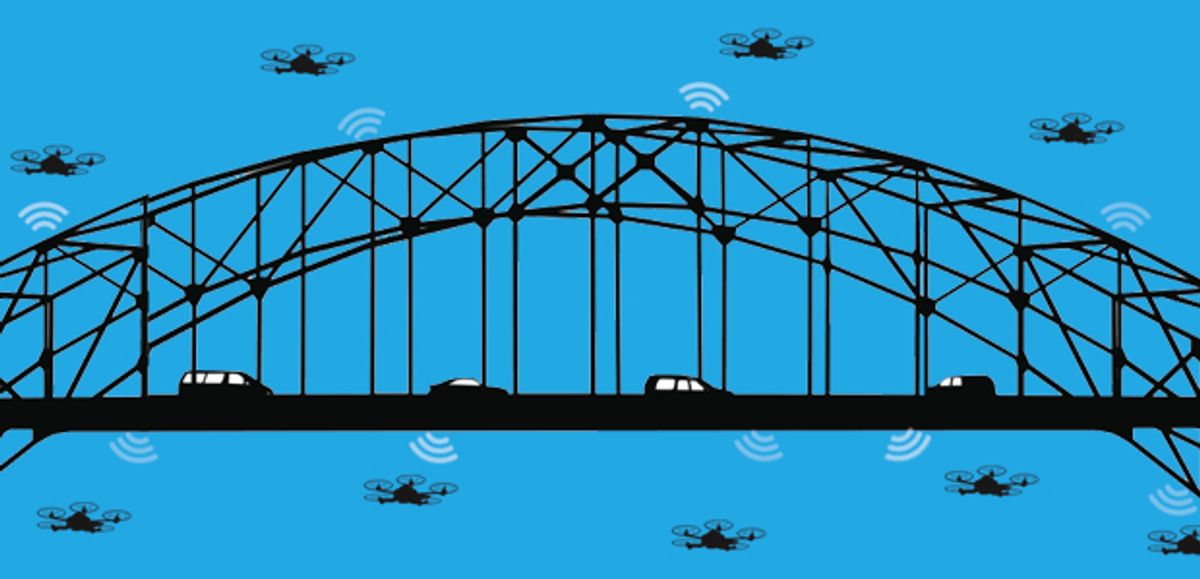Checking for cracks, rust, and other wear and tear on bridges and other infrastructure can be a pretty old-fashioned endeavor. Teams of civil engineers maneuver beneath bridges manually inspecting joints and beams for damage that could cause them to collapse under pressure. Now, a pair of professors at Tufts University are building a system that combines vibration sensors and quadcopter drones to keep an eye on bridges in real time and alert engineers when something is amiss.
For years, Tufts University civil engineering professor has been working on ways to keep tabs on the structural health of bridges on a day-to-day basis. In 2009, Moaveni and his students affixed 10 sets of accelerometers and thermal sensors to the Dowling Hall footbridge on the Tufts campus in Medford, Mass. Those sensors relay five minutes of data gathered every hour to a small server housed in a weatherproof case near the bridge. By analyzing the pattern of vibrations traveling through the structure, Moaveni and his team can identify changes in that pattern that could suggest damage to part of the bridge.
Now, Moaveni is working with Usman Khan, an assistant professor of electrical and computer engineering at Tufts, to manage the system wirelessly. The problem is, having the sensors transmit data long distances over a wireless network isn’t very energy efficient.
“Using a sensor to wirelessly communicate its collected data would drain its battery pretty fast,” says Khan.
His proposed solution is to use drones to download information from the bridge sensors. Rather than sending to a central server, Khan says that sensors could store data locally on RFID tags. A small group of drones could then operate under the bridge, flying close enough to the sensors to download the information by reading it off of the RIFD tags. The drones would then return to a nearby charging station or mobile base and share the new data with a server.
If that sounds like a complicated solution, it’s also one with a lot of potential upside. Drones could not only read and download the information from each sensor, they could respond to the information they’re getting, telling a particular sensor to gather extra data or alerting civil engineers to a potential problem.
“If a reading is off from normal,” says Khan, “the drone can be programmed to take pictures so we can see if there is rust on a nearby beam, for example.”
The drones could also potentially reprogram sensors on the fly. Sensors that usually gather data every hour on the hour could be reset to record data only during rush hour, for example. That would let researchers gather a wider variety of data about bridge performance without needing to dispatch a programmer every time they want to ask a new question.
Working beneath a bridge would present navigation problems for drones, as they wouldn’t be able to maintain GPS contact and could be left flying blind. Rather than relying on GPS, the robots could navigate by QR codes placed next to sensors, which would function like markers on a map, telling a visiting drone ‘You are here’ and directing it to the next marker. It's a navigation technique Khan and his students have already demonstrated in the lab, as you can see it in the video below.
Since factors like strong winds and limited visibility could complicate navigation beneath bridges, Khan suggests distributing the navigation tasks across a network of drones. Working together, multiple robots would be able to compare positions and check one another’s flight paths to ensure they remain accurate.
“You need a lot of intelligence to perform a complex task like this,” says Khan. “A decentralized network lets you spread the work over multiple robots.”
In addition to the technical challenges, Khan says that he and Moaveni have to raise awareness of the potential for robots in civil engineering. They hope to complete a full demonstration of the drone data gathering program on the Dowling Hall footbridge in the next couple of years to show the potential of the system for larger bridges around the nation.
If drones can be made useful for monitoring the condition of bridges, they’ll likely have their work cut out for them. According to a July report from the White House, one out of every four bridges in the United States either needs repair [pdf] or is not equipped to handle modern traffic loads.



